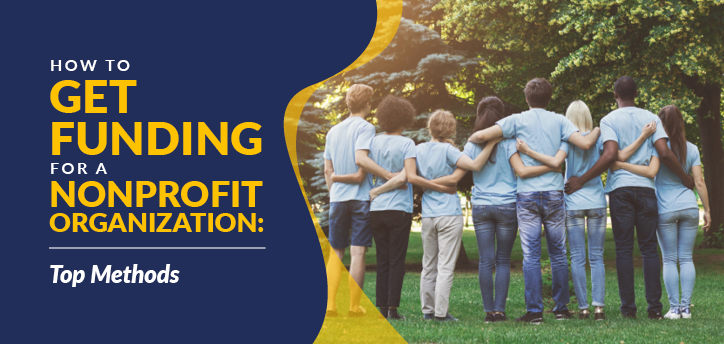6 Foolproof Ways to Get More Funding for Your Nonprofit
In a perfect world, all the money a nonprofit raises would go toward its cause. However, nonprofits incur expenses like any organization, so some, like marketing costs, will inevitably go toward overhead. To maximize your budget and allocate as much money as you can toward your mission, take the time to develop the perfect fundraising techniques.
In this guide, we’ll cover tips, tricks, and ideas that can help you achieve your fundraising goals:
- How To Get Funding for Your Nonprofit: 6 Sources
- 4 Quick Tips for Funding Your Nonprofit Organization
Are you looking for ways to raise money for your mission-driven organization? There are many viable options available for you to choose from. Read on to see what’s out there.
How to Get Funding for Your Nonprofit Organization: 6 Sources
When choosing your nonprofit’s funding sources, consider the size, mission, and other defining characteristics of your nonprofit. Create a ratio with your goals in mind—for example, you might obtain 50% from grants, 20% from a membership program, and the remaining 30% from an annual event. Remember to prioritize revenue diversification to avoid relying too heavily on one income source.
Below, we’ve organized these sources into six main categories:

1) Individual donations
According to the Giving USA Annual Report, the largest portion of charitable donations came from individual donors in 2022. Individuals contributed a total of $319.04 billion, making up 64% of total giving in America.
Here are four types of individual donations your nonprofit could pursue as part of your funding model:
- Major donations: These consist of large, one-time donations from a wealthy individual. Over the last five years, gifts of over $1,000 have grown to make up 85% of the average nonprofit’s revenue. If you need help identifying prospective major donors, consider using prospect research wealth screening tools to assess your donors’ affinity and capacity to give.
- Mid-sized donations: While smaller in size, nonprofits typically receive mid-sized donations more often. They can be made on a one-time or recurring basis (monthly, annually, etc). Because they are consistent and reliable, recurring gifts add financial stability to an organization’s funding model.
- Fees for products/services: Organizations like hospitals and other public health clinics often charge for provided goods and services to offset costs. To account for lower-income individuals, consider incorporating a sliding scale for your fees based on annual income.
- Alumni: If you serve a large community with a high turnover rate (think universities, hospitals, etc), then consider reaching out to your alumni network. They’ve benefited from your services in the past, and chances are, they would love to help you continue supporting your mission.
Remember to focus on obtaining a mixture of these different fundraising avenues to diversify your revenue, offer multiple ways for supporters to give to your cause, and improve your financial stability.
2) Corporate philanthropy
Corporate philanthropy refers to the ways that corporations give back to nonprofits and other mission-driven organizations.
Here are some of the most common ways corporations contribute to nonprofits:
- Matching gifts: Corporate matching gifts are a form of corporate philanthropy in which corporations match the donations of their employees (i.e., you get double the money of a typical donation amount). You’ll need to spread awareness of these opportunities to your supporters to receive the matched gift.
- Volunteer grants: If an employee at a corporation volunteers with a specific nonprofit often, their employer could offer a grant based on their volunteer hours. Of all Fortune 500 companies, 40% offer a program like this—spread awareness about these opportunities to take advantage of them.
- Pro bono services: In lieu of monetary donations, many corporate professionals will offer their services and expertise to mission-driven organizations free of charge. If you ever need a doctor, lawyer, or any other kind of specialist, be on the lookout for professionals who could potentially help you for free.
Remember that your nonprofit can also request and accept in-kind gifts from corporations. Similar to pro bono services, these gifts are items that an organization donates to your organization for free—think new computers or canned goods for your food pantry.
3) Events
Events are a great way to both spread the word about your nonprofit and raise money for your cause. They give you the opportunity to engage face-to-face with current supporters, as well as reach new audiences by way of an exciting activity.
Some fun event ideas could include:
- Hosting a concert.
- Throwing a gala.
- Running an online charity auction.
- Coordinating a 5K race.
- Setting up a day of volunteering events.
- Putting on a fun carnival or festival.
Remember to thoroughly market your event through social media, Google Ads, direct mail, and event flyers to ensure people are aware of it.
4) Online fundraising
It’s no secret we live in a digital world, and nonprofit fundraising is no exception. Taking advantage of online fundraising can help you extend your nonprofit’s reach beyond your local area, and it makes the giving experience much more convenient.
Consider one of these three online fundraising tactics:
- Crowdfunding: Crowdfunding refers to the collection of many small donations from a large public group of people. Platforms like GoFundMe are prime examples of crowdfunding efforts.
- Monthly giving program: Nonprofit websites easily facilitate the setup of recurring donations. Add a section to your site where people can easily register to give a certain amount per month, year, or another set time frame.
- Social media fundraising: With Instagram, Twitter, Facebook, and more, fundraising is as simple as drafting and uploading a post. Prioritize posting engaging video content as studies show that viewers will retain an average of 95% of a message conveyed in video form compared to only 10% in text form.
On the whole, online fundraising tactics are a great way to reach a lot of people without spending a lot of cash.
Want to stay up-to-date on the latest online fundraising and marketing strategies? Sign up for our newsletter!
5) Offline outreach
While online funding strategies are increasingly popular, don’t forget to use traditional outreach methods for a more personal touch.
Here are three offline fundraising ideas your nonprofit should consider:
- Direct mail: Send mail to current and potential donors to inform them about your nonprofit, thank current donors for their contributions, or even solicit donations. Make sure to link mail to your digital marketing efforts by including QR codes or URLs to your website or donation form.
- Out-of-home (OOH) advertising: This outreach method refers to any advertising experienced outside the home, like fundraising flyers, posters, billboards, and other signage. While renting space on a billboard can be costly, you could curb costs by asking local businesses to display your flyers.
- Phone calls: Nonprofits can call people directly to ask for donations. Whether in the form of cold calling or reaching out to people your organization has interacted with, this is a viable way to raise money for your cause.
Offline methods are a great way to build more personal relationships with your donors. And, they help you establish multiple touchpoints with donors so you have more opportunities to make an impression on them.
6) Grants
A grant consists of funds given to a nonprofit organization based on its industry, mission, size, and other eligibility considerations.
Grants come in all shapes and sizes, but there are three main categories:
- Unrestricted funds: Organizations can use the money wherever it will make the biggest difference.
- Capital support: This grant is designated for a specific campaign, such as a construction project or another big program.
- Restricted funds: This is the most common type of grant and is limited to a particular purpose.
To find nonprofit grants, look for the following two grant sources: government grants and private grants.
Government grants come from federal, state, and local governments. The federal government spends over $500 billion annually on grants to state and local governments, making them the third largest portion of the U.S. government’s budget.
These grants are rewarded to a variety of industries, including:
- Health
- Education
- Transportation
- Natural resources and the environment
- Community development
Private foundation/business grants come from private entities such as companies, foundations, and even individuals. A prime private grant example is the Google Ad Grants program. The Google Ad Grant is an advertising grant that gives eligible nonprofits $10,000 a month in ad credits to boost their organization to the top of Google’s search results.
To receive the Google Ad Grant, your nonprofit must submit an application and remain active on its account. For help applying, reach out to Getting Attention.
4 Quick Tips for Funding Your Nonprofit Organization
We’ve covered a lot of ground when it comes to nonprofit marketing—but don’t walk away without some quick helpful hints. As a final piece of guidance, here are four tips for creating your organization’s funding model:

- Plan ahead. It’s much better to be proactive than reactive. You need to have reliable funding sources lined up well before you actually need them. Consider your nonprofit’s needs, do your research, and lay the groundwork before diving in.
- Assess where you’re at. Ask questions about your current funding model: What’s working, and what’s not? Is each funding source reflective of your mission and values? Use the answers to make decisions on which fundraising methods to use.
- Get creative. Avoid missing opportunities by thinking outside the box. Get together with your team and brainstorm unconventional ways your nonprofit funding model could stand out.
- Be analytical. Balance your creativity by keeping in mind which methods give you the best return on investment. Focus your time and energy on what will be most reliable, profitable, and feasible.
Last, don’t be afraid to get started. After all of your careful planning, you’ll have a good idea of the best course of action to take—and remember that you can always adjust as you go.
Additional Resources
You know how important securing funding for your nonprofit is. These funds fuel your organization’s efforts to move you closer to achieving your mission. To make the most of your available resources while spreading awareness of your organization, consider reaching out to our consultants at Getting Attention for more information about the Google Ad Grants program.
For more useful information on everything nonprofit funding, read more from our library of nonprofit marketing resources:
- 6 Steps to Hire an Excellent Nonprofit Marketing Consultant. While important to your nonprofit’s success, marketing isn’t always easy. Learn how to hire the best consultant for your needs.
- Nonprofit Marketing: A Guide for Amplifying Your Mission. Ready to learn more about nonprofit marketing? Check out this guide and start launching successful campaigns.
- Google Grants Eligibility: Is Your Nonprofit Eligible? If you’re intrigued by the world of Google Ads, check out this guide to see if your organization is eligible for $10,000 worth of free Google Ad credits.




